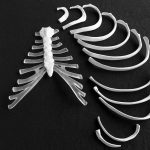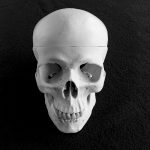 This February, Langara Library added a human skeleton anatomy model to its collection and joined the growing ranks of public and academic libraries lending not just books and videos, but also “stuff”. These non-traditional collections are sometimes popularly referred to as The Library of Things. Like many other Thing Libraries, Langara acquired these non-traditional materials in response to local needs.
This February, Langara Library added a human skeleton anatomy model to its collection and joined the growing ranks of public and academic libraries lending not just books and videos, but also “stuff”. These non-traditional collections are sometimes popularly referred to as The Library of Things. Like many other Thing Libraries, Langara acquired these non-traditional materials in response to local needs.
The library first heard from an instructor who wanted registered massage therapy students to have access to human bone models for practice and learning outside the lab. Ideally bone models that students could borrow and take home with them. When librarians reached out to other departments, we discovered that anthropology, biology and kinesiology students might have similar needs.
So the Library was soon on board with getting a skeleton model – we just weren’t sure exactly how to go about it.
It can be challenging for libraries to find a source to buy non-traditional materials, and to know exactly what to buy. Library staff know where to find books and e-books, but bones? Plastic bones, we hope? Fortunately we had expert advice from Langara instructors and lab instructors on choosing and sourcing a half skeleton model (they are all plastic), and then further help on sorting the bones in the “disarticulated human half skeleton model” when it arrived. We carefully catalogued the 14 bone sets, ordered special packaging materials, designed package labels, took photos to add to labels, and bought climbing rope to string together each of the 3 of vertebrae sets. Some of us in the library learned a bit about human anatomy for the first time! After consultations, our library systems manager wrote a new loan rule to best match student needs for borrowing the bone sets (3 day loan, maximum of 6 sets, no renewals).
 The skeleton model has been in the collection just over a month now, and response from students has been good, though use dropped off after the first week. One group reported they appreciated being able to physically handle the bones, and they felt it helped them to remember better. So far, the cranium-mandible has proved to be the most popular bone set. Because this is the first skeleton in the Library’s collection, we’ll monitor to see how the bone sets are used, whether any problems crop up, and whether additional resources like this would be warranted.
The skeleton model has been in the collection just over a month now, and response from students has been good, though use dropped off after the first week. One group reported they appreciated being able to physically handle the bones, and they felt it helped them to remember better. So far, the cranium-mandible has proved to be the most popular bone set. Because this is the first skeleton in the Library’s collection, we’ll monitor to see how the bone sets are used, whether any problems crop up, and whether additional resources like this would be warranted.
Adding the skeleton model to the Library collection was made possible by Langarans both inside and outside the Library who contributed their advice and expertise. A huge thank you to: Petra Hun, Paula Jaspar, Cora Van Wyck, Sandra Connors, Ngoc Le, Janet Whyte, Louise Reid, Julie Cole, Emma Lawson, Annie Jensen, Dana Maslovat, Mario Moniz de Sa, Stan Copp, Glenda McClean, and Ryan Vernon. – Alison Curtis

